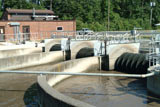
Case Study: Orbal
Plant on Chesapeake Bay Significantly Reduces TN, TP
 The King George County Wastewater Treatment Plant in Dahlgren, Va., needed to optimize its total nitrogen (TN) and total phosphorus (TP) removal to meet annual nutrient poundage caps allocated to "significant discharger" plants by the Chesapeake Bay nutrient regulations.
The King George County Wastewater Treatment Plant in Dahlgren, Va., needed to optimize its total nitrogen (TN) and total phosphorus (TP) removal to meet annual nutrient poundage caps allocated to "significant discharger" plants by the Chesapeake Bay nutrient regulations.
The plant treats 0.25 million gallons per day (mgd) but is designed for 1 mgd. Its nutrient discharge poundage allocation translates to 12 mg/L TN and 0.3 mg/L TP in the plant effluent at current flow.
In the early 1990s, Siemens Water Technologies provided the facility with a three-channel Orbal® biological nutrient removal process. In 2004, the plant added a SmartBNR™ control system, a mixed liquor suspended solids (MLSS) recycle pump, and a fourth Orbal channel. Although the plant met its discharge requirements, the design engineer wanted to increase plant performance.
In 2007, Siemens worked with the Timmons Group to create a process optimization program for the plant. Key process recommendations included reducing oxygen delivered to the first two channels; automating aerators in the same two channels and allowing the controls to determine appropriate oxygen delivery; running the MLSS recycle pump at twice the influent flow rate; and reducing holding and aeration time in the flow equalization basin to increase influent biochemical oxygen demand.
One month into the program, the upgraded Orbal system had reduced effluent TN from 12 mg/L to less than 4 mg/L. The SmartBNR controls allowed for improved process performance and reduced operating costs. Power usage for aeration was reduced by about 25 percent, and chemical costs for phosphorus precipitation and supplemental alkalinity were cut in half.